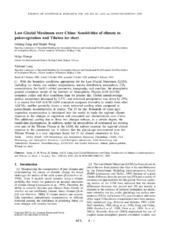Last Glacial Maximum over China: Sensitivities of climate to paleovegetation and Tibetan ice sheet
Journal article, Peer reviewed
Permanent lenke
https://hdl.handle.net/1956/401Utgivelsesdato
2003-02-06Metadata
Vis full innførselSamlinger
Originalversjon
https://doi.org/10.1029/2002jd002167Sammendrag
With the boundary conditions appropriate for the Last Glacial Maximum (LGM), including ice sheets, sea surface temperatures, sea-ice distribution, atmospheric CO2 concentration, the Earth’s orbital parameters, topography, and coastline, the atmospheric general circulation model of the Institute of Atmospheric Physics (IAP-AGCM) computes colder and drier conditions than for present day. Global annual-average surface temperature decreased by 5.3°C, and terrestrial precipitation was down by 29%. It is shown that IAP-AGCM LGM simulation compares favorably to results from other AGCMs, and/but generally shows a weak terrestrial cooling when compared to paleoclimatic reconstructions in tropics. The 21 ka (ka: thousands of years ago) vegetation reconstruction is introduced into the model to study the regional climate response to the changes in vegetation and associated soil characteristics over China. The additional cooling due to these two changes reduces, to a certain degree, the model-data discrepancies. In addition, under the precondition of continental ice existing over part of the Tibetan Plateau at the LGM, the authors examine the regional climate response to the continental ice. It follows that the glacial-age environment over the Tibetan Plateau is a very important factor for 21 ka climate simulation in East Asia.
